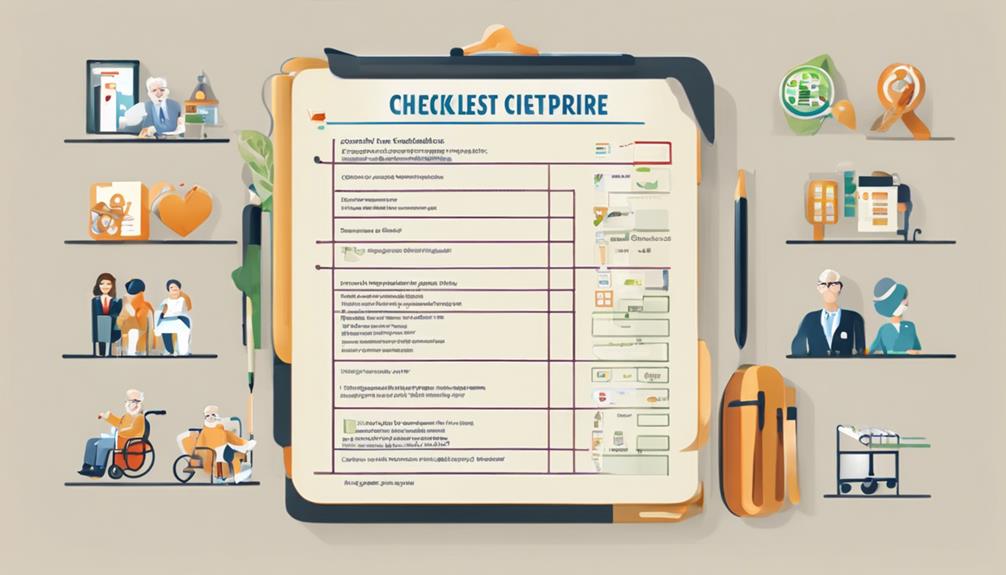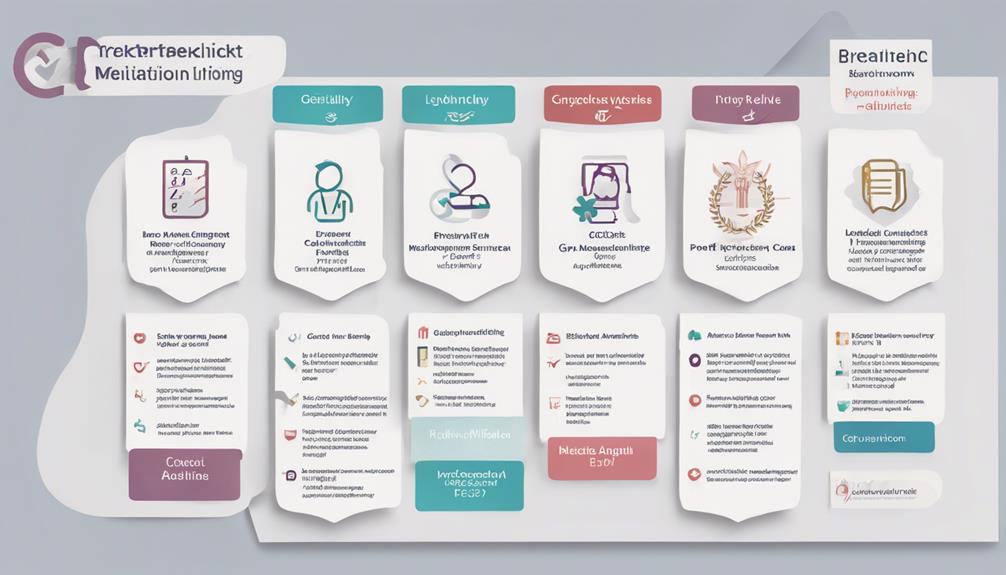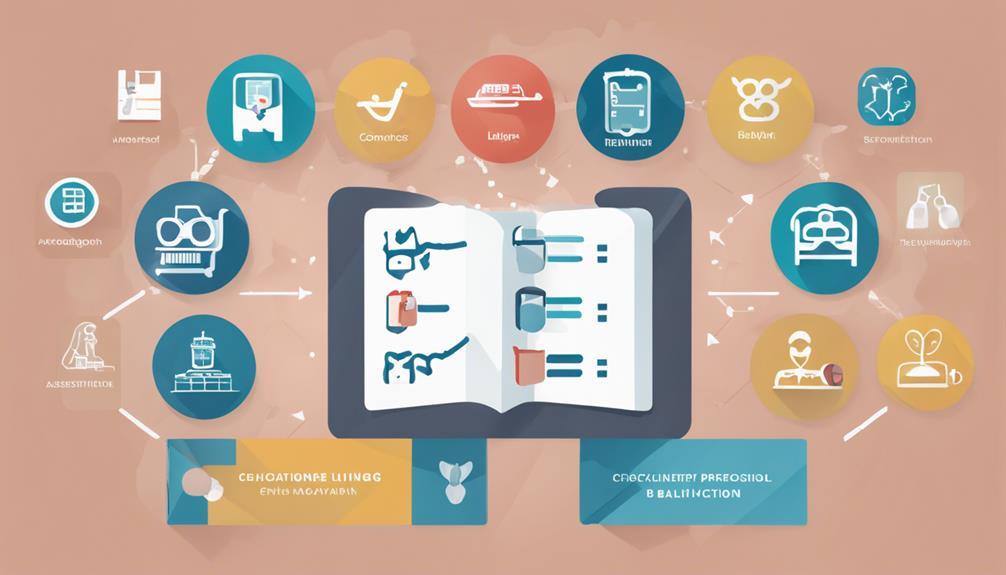When considering the essential requirements for qualifying for assisted living, it is crucial to demonstrate a need for nursing home-level care. The New York State Department of Health oversees the process and necessitates comprehensive documentation from healthcare providers. Financially, it is important to comprehend income thresholds and available assistance programs. Eligibility criteria vary by state, with New York having its own set of requirements, such as income limits and Medicaid acceptance. Enrollment is subjected to rigorous criteria, including assessments for behaviors and medical needs. Proper financial planning is key, with income limits and SSI assistance being options. By being familiar with these criteria, you can ensure a smooth qualification process.
Key Takeaways
- Demonstrated need for nursing home level of care is essential.
- Thorough documentation from healthcare professionals is required.
- Financial eligibility with limited income thresholds is crucial.
- Specific state criteria and income limits must be met.
- Medicaid acceptance with access to home health services is important.
Demonstrated Need for Nursing Home Level of Care
We must demonstrate a clear need for a nursing home level of care to qualify for an Assisted Living Program in New York. This criterion guarantees that individuals who require a higher level of assistance receive the appropriate care within an Assisted Living Facility (ALF). The New York State Department of Health regulates these programs to safeguard residents' well-being and safety. When applying for ALP enrollment, it's important to provide thorough documentation from healthcare professionals detailing the necessity for nursing home-level care.
Meeting the income limits is another important aspect when considering Assisted Living qualification. The set limits for 2024 stand at $1,732 per month for individuals and $3,464 per month for couples. Additionally, individuals residing in ALFs can access Medicaid home health services if they meet the nursing home level of care criteria. Understanding these requirements is crucial for individuals seeking ALP enrollment and navigating the process effectively.
Limited Income Thresholds

When applying for Assisted Living Programs, it's crucial to comprehend the Limited Income Thresholds. These thresholds determine if individuals or couples meet the financial criteria for assistance.
Income Eligibility Requirements, Financial Assistance Programs, and the Income Verification Process are key aspects to keep in mind when evaluating eligibility for ALPs.
Income Eligibility Requirements
In 2024, the income limits for the Assisted Living Program (ALP) in New York stand at $1,732 per month for individuals and $3,464 per month for couples. To qualify for ALP enrollment, individuals must demonstrate a need for a nursing home level of care. ALPs offer higher income thresholds than regular Medicaid, making them a suitable option for those requiring extensive care.
It's essential to highlight that ALPs don't cover room and board costs; however, Supplemental Security Income (SSI) can help offset these expenses for residents. Additionally, residents in Assisted Living Facilities (ALFs) have access to Medicaid home health services to support their care needs. Understanding these income eligibility requirements is vital for individuals considering assisted living options.
Financial Assistance Programs
Limited income thresholds serve as a determining factor for eligibility in financial assistance programs available for individuals seeking support with assisted living costs. For instance, in New York, the Assisted Living Program (ALP) sets income limits at $1,732 per month for individuals and $3,464 per month for couples in 2024.
ALPs have slightly higher income thresholds compared to regular Medicaid programs. To qualify for ALP, individuals must demonstrate a need for a nursing home level of care. It's essential to note that ALPs don't cover room and board costs; however, Supplemental Security Income (SSI) could help cover these expenses.
Due to specific eligibility criteria and limited enrollment, not everyone qualifies for ALP financial assistance.
Income Verification Process
To successfully qualify for Assisted Living Programs (ALPs) in New York, individuals and couples must adhere to specific income limits set by the program. For individuals, the income limit stands at $1,732 per month, while couples applying for ALPs need to meet a combined income limit of $3,464 per month. These income thresholds are higher than those of regular Medicaid programs.
Income verification is an important step in determining eligibility for ALPs, ensuring that those in need receive the necessary support. Meeting the income requirements is essential for qualifying for Medicaid coverage within ALPs, providing individuals and couples with the assistance they require to access quality care and support.
Specific Eligibility Requirements by State

When considering eligibility for assisted living programs in different states, one must be aware of the specific criteria required.
In New York, individuals seeking to qualify for the Assisted Living Program (ALP) must demonstrate a need for a nursing home level of care. Additionally, there are income limits set at $1,732 per month for individuals and $3,464 per month for couples in 2024. ALPs in New York hold a special license to accept residents covered by Medicaid.
It's essential to recognize that ALPs don't cover room and board costs; however, Supplemental Security Income (SSI) may help cover these expenses. Furthermore, ALPs in New York have a higher income limit compared to regular Medicaid programs.
Understanding these specific eligibility requirements by state, especially in New York, is vital for individuals considering assisted living options.
New Yorks Assisted Living Program Criteria

In New York, individuals must demonstrate a need for a nursing home level of care to qualify for the Assisted Living Program (ALP). This requirement guarantees that those who truly require the services provided by ALPs receive the necessary support.
ALP enrollment in New York is limited, meaning not all applicants may qualify for the program due to capacity constraints. To be eligible for ALP in New York, individuals must meet income limits, which are set at $1,732 per month for individuals and $3,464 per month for couples in 2024.
The ALPs in New York are closely regulated by the New York State Department of Health to ensure that residents receive high-quality care and services. Additionally, residents in Assisted Living Facilities (ALFs) in New York have the option to access Medicaid home health services for extra support if needed.
Meeting these criteria is crucial to proper enrollment in the ALP and receive the necessary care and assistance.
Enrollment Restrictions and Capacity Considerations

Considering the limited enrollment capacity of Assisted Living Programs (ALPs), individuals must meet strict criteria to secure a spot in the program. ALPs in New York, regulated by the New York State Department of Health, have specific income limits. For individuals, the income limit is $1,732 per month, while for couples, it's $3,464 per month.
To qualify for ALPs, individuals must demonstrate a need for a nursing home level of care. It's important to note that ALPs don't cover room and board costs. However, individuals may be able to seek assistance through Supplemental Security Income (SSI) to help cover these expenses.
Understanding the enrollment restrictions and capacity considerations of ALPs is essential for those looking to benefit from these programs. By meeting the income limits and demonstrating the required level of care need, individuals can take steps towards securing a place in an Assisted Living Program.
Understanding Essential Qualification Criteria

Moving from discussions regarding enrollment restrictions and capacity considerations, let's now focus on what individuals need to meet regarding essential qualification criteria for Assisted Living Programs (ALPs).
To qualify for Assisted Living, individuals must require support with daily living activities such as dressing, grooming, and meal preparation. It's important to have stable health conditions, typically manageable chronic illnesses, to be eligible for ALPs. However, individuals with severe dementia requiring memory care, those who are bedridden, or individuals needing around-the-clock nursing care may not meet the qualification criteria for Assisted Living.
Prospective residents may undergo physical assessments to determine their level of assistance needs and create personalized care plans tailored to their requirements. Additionally, providing a detailed medical history is often necessary for staff evaluation and the development of thorough care plans.
Assessment of Behaviors and Medical Needs

Assessing both behaviors and medical needs plays a crucial role in determining the level of care and support individuals require in an assisted living setting. Behavioral evaluations are conducted to guarantee compatibility with staff and residents, fostering a harmonious community atmosphere.
On the other hand, medical needs assessments cover a variety of aspects including existing conditions, required medications, and specific care needs essential for personalized care plans. These assessments are based on thorough evaluations that help in creating a tailored approach to meet the unique requirements of each resident.
Financial Planning and Assistance Options

Exploring various financial planning and assistance options is essential for individuals seeking to navigate the costs associated with assisted living facilities.
In New York, Assisted Living Programs (ALPs) have specific income limits set at $1,732 per month for individuals and $3,464 per month for couples in 2024. Supplemental Security Income (SSI) can aid in covering room and board expenses for ALP residents. To qualify for ALPs, individuals must demonstrate a need for a nursing home level of care. Additionally, ALPs in New York are licensed to accept Medicaid residents, enabling access to Medicaid home health services.
Understanding these financial aspects is vital for prospective residents and their families to plan effectively for the expenses associated with assisted living. By exploring options like SSI and Medicaid, individuals can better prepare for the financial obligations of residing in an ALP while ensuring they meet the necessary income limits and care requirements.
Frequently Asked Questions
What Are the Three Principles of Assisted Living?
We believe the three principles of assisted living are stability, independence, and tailored services. These principles focus on providing predictability, promoting autonomy, and offering personalized care plans to guarantee residents' needs are met thoroughly and compassionately.
Who Qualifies for Assisted Living in New York?
We qualify for assisted living in New York by demonstrating a need for a nursing home level of care. The income limits are $1,732 per month for individuals and $3,464 per month for couples. ALP enrollment is limited, ensuring quality care.
What Are the Three Characteristics That Refer to an Assisted Living Facility?
We believe assisted living facilities offer a blend of independence and care, emphasizing quality of life for seniors. These places provide housing, personal assistance, and promote social connections. Residents receive support with daily tasks to maintain independence. Senior assisted living explained is a balanced approach that tailors services to meet individual needs while fostering autonomy. With access to recreational activities and healthcare services, residents can enjoy a vibrant and fulfilling lifestyle. It’s an environment designed to nurture well-being and personal growth, allowing seniors to live comfortably and with dignity.
Will Medicaid Pay for Assisted Living in New York State?
Yes, Medicaid may cover assisted living in New York State. It's essential to meet the required level of care and income limits. Room and board costs are typically not included, but SSI assistance might help with expenses.
Conclusion
To sum up, meeting the essential criteria for assisted living qualification is like finding your way through a maze – it requires careful planning and attention to detail. By demonstrating a need for nursing home level of care, meeting income thresholds, and fulfilling specific state requirements, individuals can access the support they need.
Understanding these criteria and exploring financial assistance options are key steps in the process. Just like a map guides us through unknown territory, these qualifications can lead individuals to the right path towards assisted living services.









